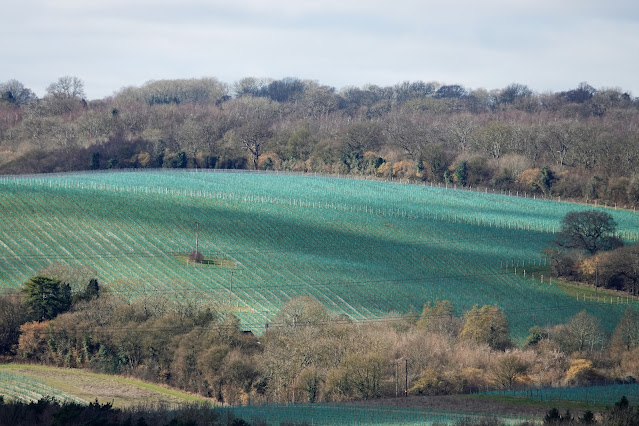A www.blueyedbirder.com day out...
My first scheduled Ranscombe walk of the year started well
with a fine adult Med Gull on the playing fields just minutes after meeting up
with Malcolm for our walk. It was metal
ringed and well on the way to full summer plumage. A dog walker spooked the
flock and so we moved on to the underpass and onto the loop.
 |
| Med Gull |
Bullfinches were calling as soon as we crossed the railway
and just for once perched up, albeit distantly in a Hazel. The first Coltsfoot was in flower and on
closer inspection there were still some tiny red anemone Hazel flowers to be
found.
 |
| Bullfinch |
 |
| Hazel flowers |
The Lady Orchids were poking through the Sweet Chestnut leaf
litter and the adjacent clump of Butcher’s Broom was coming into flower if you
looked really closely. King Alfred’s Cakes glistened on trunks and Lords and
Ladies were twisting into view. It was
quite warm but still breezy and I think just not quite right to entice any
insects to come out and bask.
 |
| Butcher’s Broom |
 |
| Lady Orchids |
 |
| King Alfred’s Cakes |
 |
| Lords and Ladies |
Skylarks were singing in the fields above The Valley and
gangs of Rooks and Jackdaws swirled on the gusts with two Buzzards for
company. The woods were still very
dormant and even the resident birds seemed reluctant to make themselves known. Primroses
were just starting to open on the path side and the Holly was likewise in bloom
with its waxy almost pinky flowers.
There were still some berries on the Privet that had evaded snaffling by
the Thrushes and the Spurge Laurel was in fine flower but as usual was scentless.
 |
| Primroses |
 |
| Holly |
 |
| Spooked Wood Pigeons |
 |
| Privet |
 |
| Spurge Laurel |
I fondled some Burdock seed heads but found nothing to
suggest moth larva presence but found none but had better luck with Endothenia
within several Teasel heads but I chose not to spend time check for the
presence or absence of anal cones to tie them to species!
 |
| Stigmella aurella |
 |
| Stigmella aurella (left) and Coptoptiche marginea (right). Learn these two on Bramble and you will find them almost anywhere you look |
 |
| Endothenia sp within its poo cocoon... |
We descended across Kitchen Field with Raven and male Sparrowhawk
in the now blue sky and two Meadow Pipits unusually perched atop the dying Ash
trees which were adorned with garlands of silvery Old Man’s Beard. A Green Woodpecker loudly yaffled before
actually perching up for a short while and flashing that red crown.
 |
| Old Man’s Beard |
 |
| Raven |
A party of four stag and two hind Fallow Deer were in their
favoured secure meadow and watched us cautiously. The stags looked in fine fettle.
 |
| Fallow Deer |
Up into Brockles where the view across the valley revealed
the hideously fake green of thousands of vine guards and another Sparrowhawk
and Kestrel were added as we followed the path up alongside the woods.
Malcolm found three Stonechats in the next meadow which had
not been cleared of scrub saplings yet which was pleasingly on my second record
for the site. Two males and a female
were working the field and we moved a little closer in the hope that a Dartford
Warbler may have chosen to join them but alas not! Mistletoe had obtained its almost luminescent
spring colours and the flowers were just starting to open. It looks so different at this time of year.
 |
| Mistletoe |
 |
| Stonechats |
A coffee on a log afforded fine views and the sound of
Skylark song descending from up on high before we cut through and followed the
Cobham fenceline where Bluebells were showing their new leaves to the fields
where a pair of Mistle Thrushes were seen as we popped out into the open. A
single Celandine flower was home to an Episyrphus balteatus in all its stripy
glory and there were a few lazy Calliphora vicina basking on fence posts but no
Bees or Butterflies.
 |
| Celandine |
 |
| Episyrphus balteatus |
 |
| Spears of Bluebell leaves |
Back into the Cobham Estate woods where Long-tailed Tits foraged
and a Treecreeper did what they do best while we walked down to say hello to
the Highland Cattle that were chilling out in the dead Bracken. The first furry
Yellow Dung Flies of the season were staking out a nice fresh pat and one male
was already paired up!
 |
| Yellow Dung Fly |
 |
| Just chillin' |
We walked through the hollow Chestnut and then back onto the
main drag back to the cars introducing Malcolm to some of my other favourite
trees on the way. As usual the downhill
route back was much appreciated but the woods were quiet bar from a few
foraging Tits and a Goldcrest just before we crossed back over the Eurostar
line after a pleasant five mile circuit.
I used to call it the Elephant Tree for a shape in the charcoal insides but it would appear to have developed other elephantine proportions over the winter months...
 |
| The Hollow Chestnut |
 |
| The aftermath of the October 1987 storm is still evident in the winter months with the aligned trunks of the massive Chestnuts that did not make it through. Some are dead but most still have a toehold in the stony ground and now have 35 year old regrowth from their horizontal original trunks while others have Birches growing out of their remains. |






































No comments:
Post a Comment